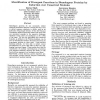Free Online Productivity Tools
i2Speak
i2Symbol
i2OCR
iTex2Img
iWeb2Print
iWeb2Shot
i2Type
iPdf2Split
iPdf2Merge
i2Bopomofo
i2Arabic
i2Style
i2Image
i2PDF
iLatex2Rtf
Sci2ools
ISMB
1998
1998
Identification of Divergent Functions in Homologous Proteins by Induction over Conserved Modules
Homologousproteins do not necessarily exhibit identical biochemicalfunction. Despitethis fact, local or global sequence similarity is widely used as an indication of functional identity. Ofthe 1327Enzyme Commissiondefined functional classes with morethan one annotated example in the sequence databases, similarity scores alone are inadequate in 251 (19%) of the cases. Wetest the hypothesis that conserved domains, as defined in the ProDomdatabase, can be used to discriminate betweenalternative functions for homologousproteins in these cases. Using machine learning methods, wewere able to induce correct discriminators for morethan half of these 251 challenging functional classes. Theseresults showthat the combination of modular representations of proteins with sequencesimilarity improvesthe ability to infer function fromsequenceover similarity scores alone.
Computational Biology | Functional Classes | Global Sequence Similarity | ISMB 1998 | Similarity Scores |
| Added | 01 Nov 2010 |
| Updated | 01 Nov 2010 |
| Type | Conference |
| Year | 1998 |
| Where | ISMB |
| Authors | Imran Shah, Lawrence Hunter |
Comments (0)

